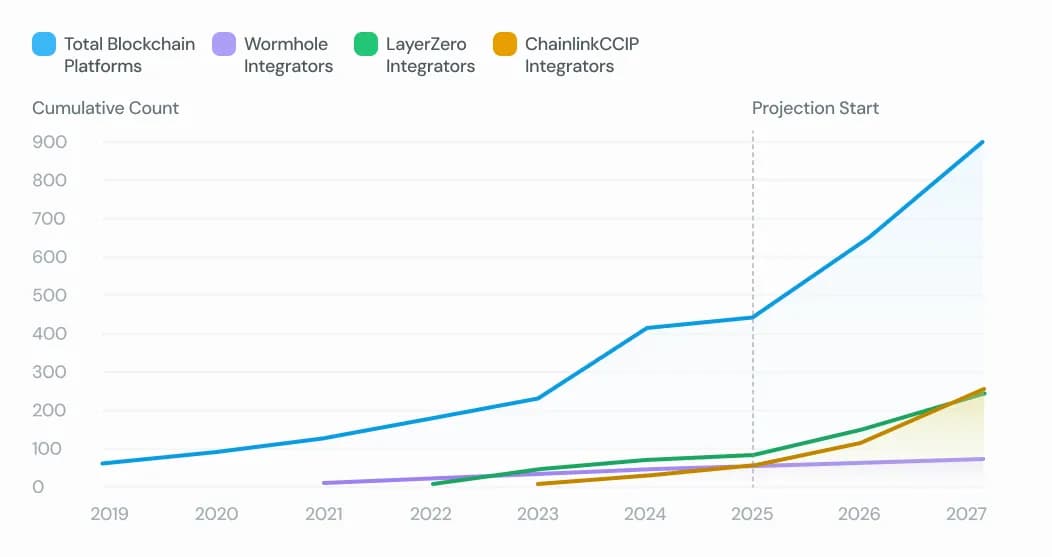Introduction
Launching a blockchain used to cost millions. Today, open‑source frameworks such as OP Stack, Arbitrum Orbit, the Cosmos SDK, and rollup‑as‑a‑service platforms like Conduit or Caldera have slashed that cost by an estimated 90 %—and analysts predict this will “1000× the number of chains being built… the future has thousands of chains”.
The result is an explosion of app‑specific chains. Pantera’s 2024 outlook calls it a “hub‑and‑spoke era of appchains” where toolkits such as OP Stack, Arbitrum Orbit and StarkEx make dedicated chains the norm.
Yet cross‑chain connectivity hasn’t kept pace. Protocols like LayerZero (120+ chains), Wormhole (30+ chains) and Axelar (60+ chains) add support one chain at a time. Meanwhile IBC already links 117 Cosmos‑based chains, but only within its own ecosystem. The result is a widening interoperability gap where new chains launch faster than existing bridges can onboard them.
 Figure 1 – While the number of blockchains (turquoise) has been compounding exponentially since 2013, the cumulative integrations of leading interoperability protocols remain stubbornly linear. Even optimistic projections leave a widening “interoperability gap” unless something fundamentally changes. The status quo treats interoperability as a premium integration rather than a default capability.
Figure 1 – While the number of blockchains (turquoise) has been compounding exponentially since 2013, the cumulative integrations of leading interoperability protocols remain stubbornly linear. Even optimistic projections leave a widening “interoperability gap” unless something fundamentally changes. The status quo treats interoperability as a premium integration rather than a default capability.
The High Cost of Connecting Chains
Integrating a new blockchain into a cross‑chain protocol is still a bespoke, six‑figure project. Public integration proposals routinely budget US $100k–200k in engineering and audit costs before a single transaction is relayed (e.g. the Moonriver × Axelar proposal earmarked $100k in incentives and audits). The Hashi bridge proposal to connect two Gnosis canonical bridges earmarked US $250 k for development, audits and migration alone Hashi Budget. These one‑off expenses explain why protocol onboarding has grown linearly, even as the number of independent blockchains multiplies.
The heavy infrastructure each protocol demands compounds that bill. Wormhole requires its 19 Guardians to run full nodes for every new chain, pushing aggregate infra spend into tens of thousands of dollars per month Wormhole docs GitHub ops. Axelar expects all 75+ validators to add and maintain nodes or light‑clients; to offset the load it inflates AXL supply by 0.75 % per chain—roughly $90‑270 k per year in validator rewards. With such recurring costs layered on top of up‑front engineering, interoperability remains an expensive, slow‑moving service in urgent need of a more scalable model.
Existing interoperability solutions don’t just face a speed-of-integration problem – they also impose significant costs and operational overhead on projects that want to connect new chains. Integrating a blockchain into a cross-chain network often requires bespoke engineering and infrastructure deployment, which can run well into six figures.
How Concero V2 Changes Interoperability
Concero V2 is a next-generation cross-chain protocol with a simple yet radical premise: inter-chain messaging should be a universal utility—frictionless, low-cost, and available by default. To deliver on that promise, Concero V2 introduces several key innovations:
| Legacy Approach | Concero V2 |
|---|---|
| Deploy light/full nodes for every new chain | Zero new nodes – leverages existing public RPC endpoints via an open‑source Trusted RPC Registry. Any chain with an RPC endpoint can opt‑in via a Pull Request and get instantly integrated without months‑long negotiations with node operator clusters. |
| Manual relayer configuration | Auto‑discovery – once a new chain’s RPC endpoints are merged, every relayer automatically begins servicing it—no side‑channel coordination, no downtime. |
| $100 k‑plus integration fees | $0 onboarding cost with $0.01 per message. No six‑figure integration fees. |
| Security scales with chain count | Relayers back their claims by slashable stake in Symbiotic, which secures all Concero-supported chains at once. |
Why Interoperability Should Be a Public Good
In an internet‑native economy, users don’t pay a toll for each packet they send, and developers don’t negotiate with ISPs to “integrate” a new website. Concero extends that paradigm to blockchains, making inteoperability cheap, fast, and available by default to every blockchain that comes online.
With launch‑costs plummeting and thousands of app‑chains on the horizon, a friction‑free message layer is the only way to meet the inevitable demand.
Concero’s thesis is that inter‑chain messaging will converge to a commodity utility, just like HTTPS or SMTP. When launching a chain becomes as easy as launching a website, connectivity must be just as frictionless as adding a new row into a JSON file.